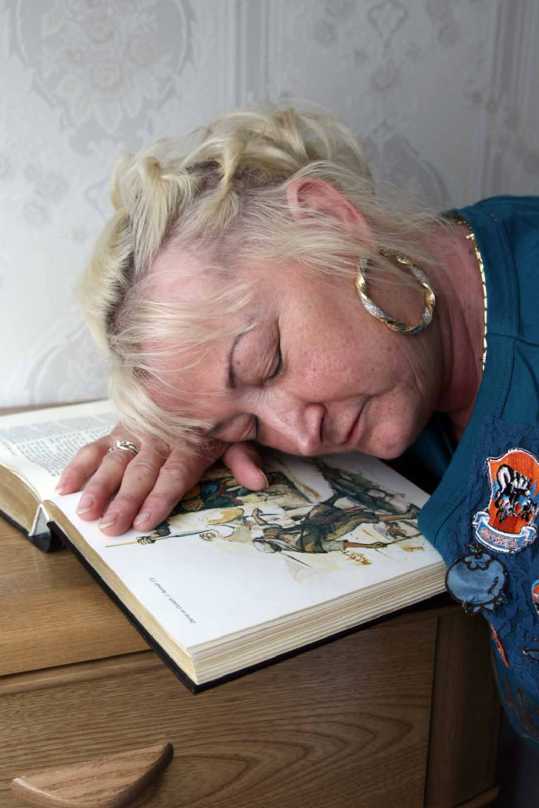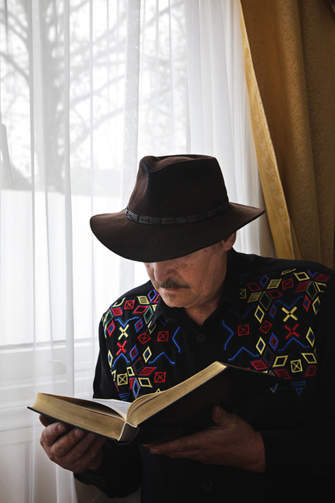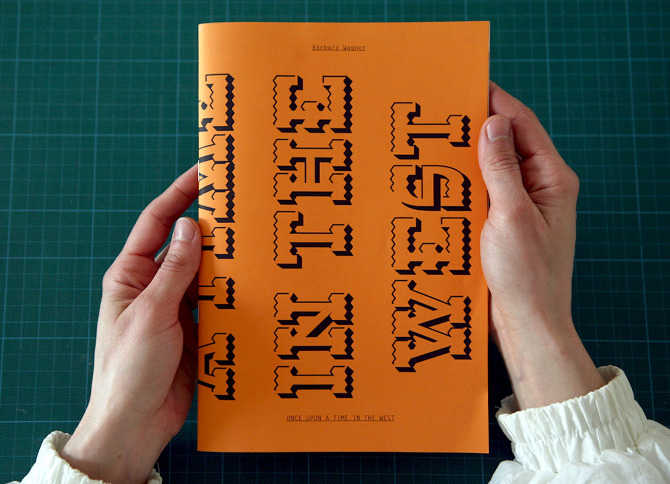2011 / Artist, editor: Bárbara Wagner / Title: Once Upon A Time In The West / Designer: Noah Venezia / Text: Inti Guerrero
"As a narrative that takes the format of a video projection and a fotonovela (1), Once upon a time... concentrates on the story of Nieding and Hendrikje Wolters, ex-travellers (2) who became notorious in the North of the Netherlands after publishing a book about their own lives, ranging from criminal convictions to evangelic belief (3). With specific attention to performance and documentary practices, a photographic sequence is enveloped within a conversation
that attempts to describe what we are seeing in order to problematize what we are not seeing, being facts and fictions equally subjected to speculation.
The work is the result of three moments of production. In the first, I work in collaboration with the Wolters on the construction of photographs that document the staging of specific passages in their biography. In a second moment, discarding the use of talking heads or speech bubbles and avoiding moral impositions (often used in fotonovelas) I invite curator Inti Guerrero to enter into a dialogue about the pictures produced. Using the recorded and transcribed
version of this conversation as the textual part of the narrative, the third moment of production is further developed with references to theatre scripts, film stills and newspaper reports to the final form of a video projection and a publication."
(1) In English, photonovel: a novel published as a series of sequential photographs coupled with dialogue enclosed in balloons. Definition:
Dictionary.com Unabridged. Random House, Inc. http://dictionary.reference.com/browse/photo novel (accessed: June 05, 2011).
(2) Group of about 30,000 people who live in trailer parks in the Netherlands, coming from a long tradition of travelling families. Often
addressed by national media as "kampers" (campers) they prefer calling themselves "reizigers" (travellers) and use the term "burgers" (citizen)
when referring to people who live in settled houses. From Dutch origin, distinguished from the Sinti and Roma their history in the country goes
back to 1850, when they used to make a living as farm workers. Today, even though their houses are no longer mobile, they keep both
structure and appearance of the former caravans, fixed on the ground.
(1) Sieberen Voordewind, Het leven van twee woonwagenbewoners, interview met Nieding and Hendrikje Wolters (Barneveld: Uitgeverij
Boekenbent, 2010). In the preface of this biography, in the words of Voordewind, "the following topics are addressed: family life in a trailer,
travel, health, marriage, violence, 'murder', revenge, prisons, burglaries, arms trafficking, healing, love, a new life and more".
Once upon a time in the West
Text by Inti Guerrero, 2011
The works by Bárbara Wagner are photographic essays that portray social groups and manifestations of popular culture, which she relates to the notions of marginality, camp and folklore today. To better get acquainted with her work, one should first bear in mind an important semantic distinction between what is understood by Pop culture
and popular culture. The first is perhaps the cultural outcome generally linked to mass-industry that produces a field of homogeneous seriality consumed by a majority of the population. In other words, it is a 'cultural industry' that does not stand for a vernacular tradition within a society but that nevertheless is assimilated and naturalized as part of culture at large. On the other hand, 'popular culture' consists of those cultural practices embedded in the idio-
syncrasy of people; rather than being produced repetitively as a seriality they arise through a rite as the simulacrum of an 'original' past tradition. In Christian societies for example, Carnival is evoked yearly as a ritual signifying the 'primordial' archetype of a traditional festivity that fosters the liberty of soul and body before Lent.
Bárbara Wagner's subjects of inquiry have to do with popular culture, not Pop culture. Her lens seeks to explore vernacular traditions that do not directly belong to the lines of mobility or forms of production of mainstream culture.
This interest emerged in Recife, in the northeast of Brazil, where she began her photographic practice as a journalist. There, she produced works that portrayed practices of leisure and festivity of lower classes and rural communities, revealing performative gestures that were internalized by the bodies of the people she photographed.
In the case of her series 'Estrela Brilhante' (2009), she travelled to villages in the countryside in order to capture a folkloric dance called Maracatu, which in Brazil is widely known for its performers that wear extravagant costumes during Carnival, giving witness of a miscegenation that mingles Amerindian, African and European milieus. In Wagner's photographs the Maracatu dancers appear rehearsing without their traditional costumes, producing uncanny images that emphasize their choreography as gestures of performativity. In other words, by stripping the
body from the folkloric ornament she lets us see through layers of local culture and presents the human body through its minimal gesticulation.
Working in Holland, Wagner was set out to examine the problem of how to find popular culture in a context where Pop culture has become the predominant imagery of identity. She encountered her subject in the woonwagenbewoners, an originally travelling Dutch community composed of families who live in trailers, and who are closer to being semi-rural squatters rather than nomads. After discovering a couple of Woonwagenbewoners who were promoting a book about their own lives on You tube - from the north-eastern small town of Hoogeveen - she interviewed and lived with
Nieding and Hendrikje for a short period of time and decided to devote a photographic essay to their biography, which ranged from criminal convictions to current evangelistic belief.
Great part of the photographic storyline presented in this book is the artist's interpretation of some of their lives' episodes, which she has assembled together in the form of an 'amateur' Western. More than being an anthropological depiction of a minority, an exotic rarity for the reader/viewer, this book shows – perhaps like the work on Maracatu dancers – the body of folkloric subjects in their most humane expression.



